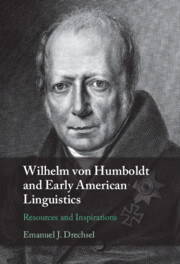Book contents
- Wilhelm von Humboldt and Early American Linguistics
- Wilhelm von Humboldt and Early American Linguistics
- Copyright page
- Dedication
- Contents
- Figures and Tables
- Maps
- Preface
- Acknowledgments
- Part I Wilhelm von Humboldt and the Americas
- Part II The Early Lives of Wilhelm and Alexander von Humboldt
- 3 The Humboldt Brothers’ Youth and Bildung in Europe of the Late Eighteenth Century
- 4 Alexander von Humboldt on His Explorations of the Americas and in His Role as His Brother’s Intermediary (1799–1804)
- 5 Wilhelm von Humboldt’s Linguistic and Ethnographic Field Experiences with Basque in the Pyrenees of Spain (1799 and 1801)
- Part III Wilhelm von Humboldt’s Americanist Linguistics
- Part IV Wilhelm von Humboldt’s Impact on Americanist Linguistics and Anthropology
- Part V Wilhelm von Humboldt as an Americanist Linguist and Anthropologist
- Book part
- References
- Index
4 - Alexander von Humboldt on His Explorations of the Americas and in His Role as His Brother’s Intermediary (1799–1804)
from Part II - The Early Lives of Wilhelm and Alexander von Humboldt
Published online by Cambridge University Press: 11 January 2024
- Wilhelm von Humboldt and Early American Linguistics
- Wilhelm von Humboldt and Early American Linguistics
- Copyright page
- Dedication
- Contents
- Figures and Tables
- Maps
- Preface
- Acknowledgments
- Part I Wilhelm von Humboldt and the Americas
- Part II The Early Lives of Wilhelm and Alexander von Humboldt
- 3 The Humboldt Brothers’ Youth and Bildung in Europe of the Late Eighteenth Century
- 4 Alexander von Humboldt on His Explorations of the Americas and in His Role as His Brother’s Intermediary (1799–1804)
- 5 Wilhelm von Humboldt’s Linguistic and Ethnographic Field Experiences with Basque in the Pyrenees of Spain (1799 and 1801)
- Part III Wilhelm von Humboldt’s Americanist Linguistics
- Part IV Wilhelm von Humboldt’s Impact on Americanist Linguistics and Anthropology
- Part V Wilhelm von Humboldt as an Americanist Linguist and Anthropologist
- Book part
- References
- Index
Summary
Understanding Alexander von Humboldt’s role in his brother’s Americanist linguistics requires an appreciation of his American explorations. In today’s eastern Venezuela, Alexander engaged in linguistic-ethnographic fieldwork with the Chaima or Kumaná (Cariban); later, he met Quechua-speaking people in the Andes and Nahuas in Mexico among other Indigenous Americans, providing valuable sociolinguistic insights for Wilhelm. Alexander’s map of explorations closely reflects Wilhelm’s early inventory of American grammars, suggesting Alexander as a primary source of Wilhelm’s early American documents. Although sometimes chastised as a colonizer, Alexander proved unusually empathetic to Indigenous peoples, recognized sociohistorical continuities from pre-Columbian to post-contact societies, and addressed issues of colonial society from a hemispheric perspective, including exploitation and slavery. While visiting the United States on his return to Europe, Humboldt voiced his abolitionist position, but gained few insights about Native Americans’ fate as part of the Louisiana Purchase of 1803 or the developments leading to their removal.
Keywords
- Type
- Chapter
- Information
- Wilhelm von Humboldt and Early American LinguisticsResources and Inspirations, pp. 65 - 80Publisher: Cambridge University PressPrint publication year: 2024



